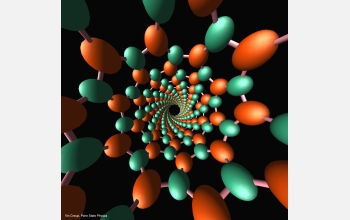Multimedia Gallery
View down the middle of a boron nitride nanotube
A team led by Vincent Crespi at PennState used supercomputers to model the electronic states and total energies of various carbon molecules and discovered a tetrahedral carbon atom that creates tight and stable bonds to form tiny tubes only six atoms across -- the smallest diameter theoretically possible. Pictured here is a view down the middle of a boron nitride nanotube.
[Research supported by U.S. National Science Foundation grant DMR 9520554.] (Year of image: 1996)
Credit: Vin Crespi, Pennsylvania State Physics (Distributed under Creative Commons license Attribution-ShareAlike 2.0 Generic)
Special Restrictions: This photo is licensed under Creative Commons Attribution-ShareAlike 2.0 Generic.
Images and other media in the National Science Foundation Multimedia Gallery are available for use in print and electronic material by NSF employees, members of the media, university staff, teachers and the general public. All media in the gallery are intended for personal, educational and nonprofit/non-commercial use only.
Images credited to the National Science Foundation, a federal agency, are in the public domain. The images were created by employees of the United States Government as part of their official duties or prepared by contractors as "works for hire" for NSF. You may freely use NSF-credited images and, at your discretion, credit NSF with a "Courtesy: National Science Foundation" notation.
Additional information about general usage can be found in Conditions.
Also Available:
Download the high-resolution TIFF version of the image. (710 KB)
Use your mouse to right-click (Mac users may need to Ctrl-click) the link above and choose the option that will save the file or target to your computer.

 All images in this series
All images in this series